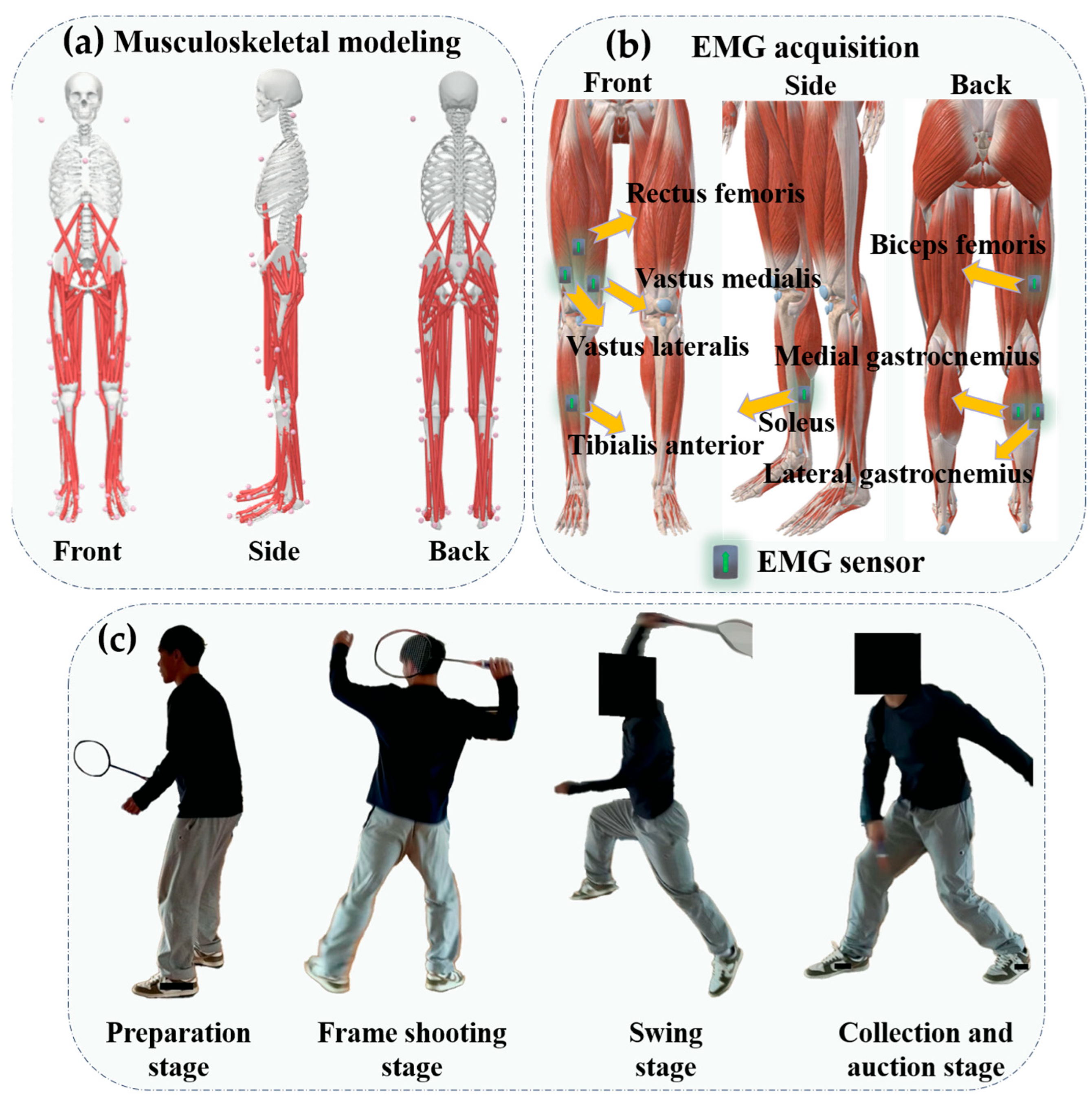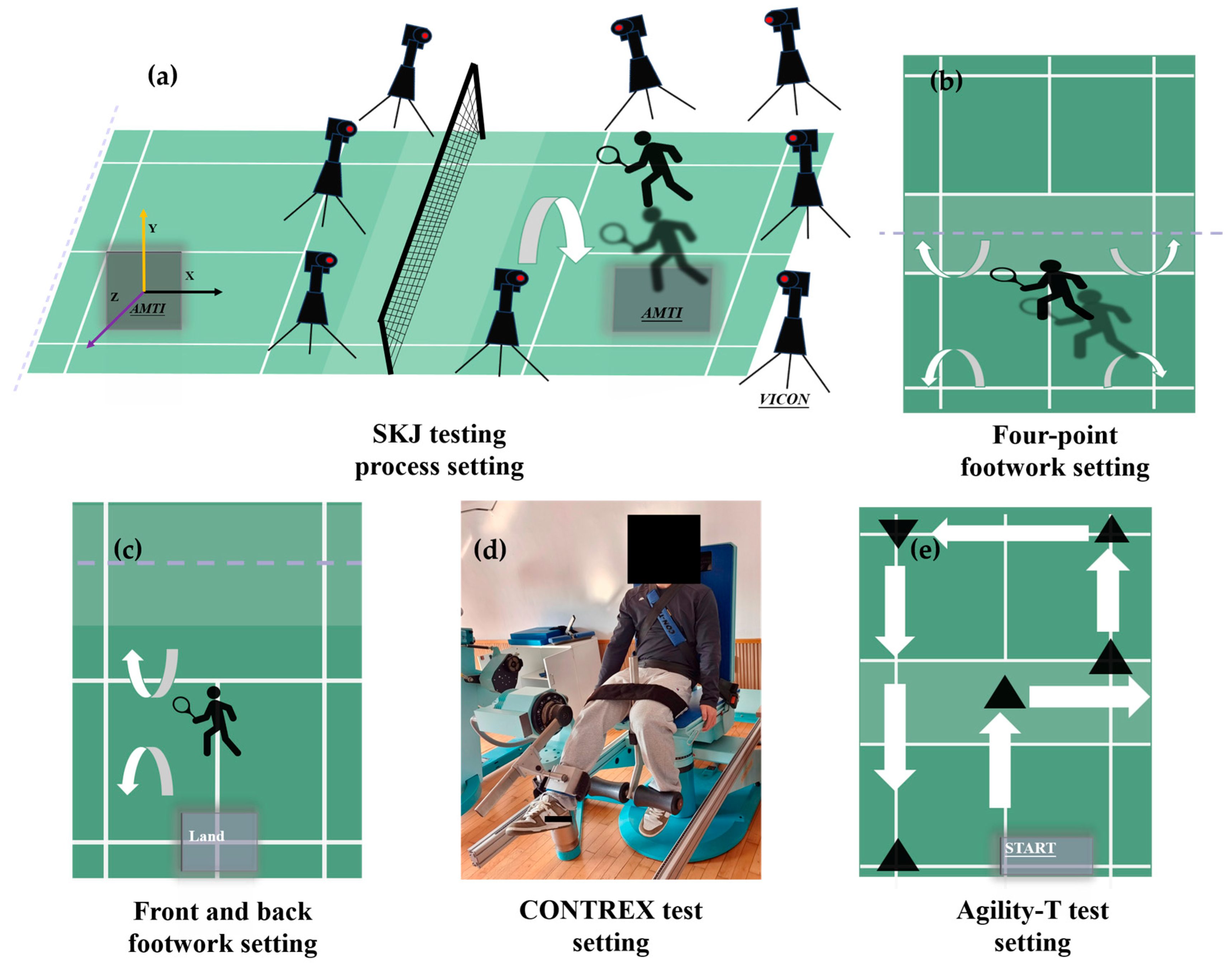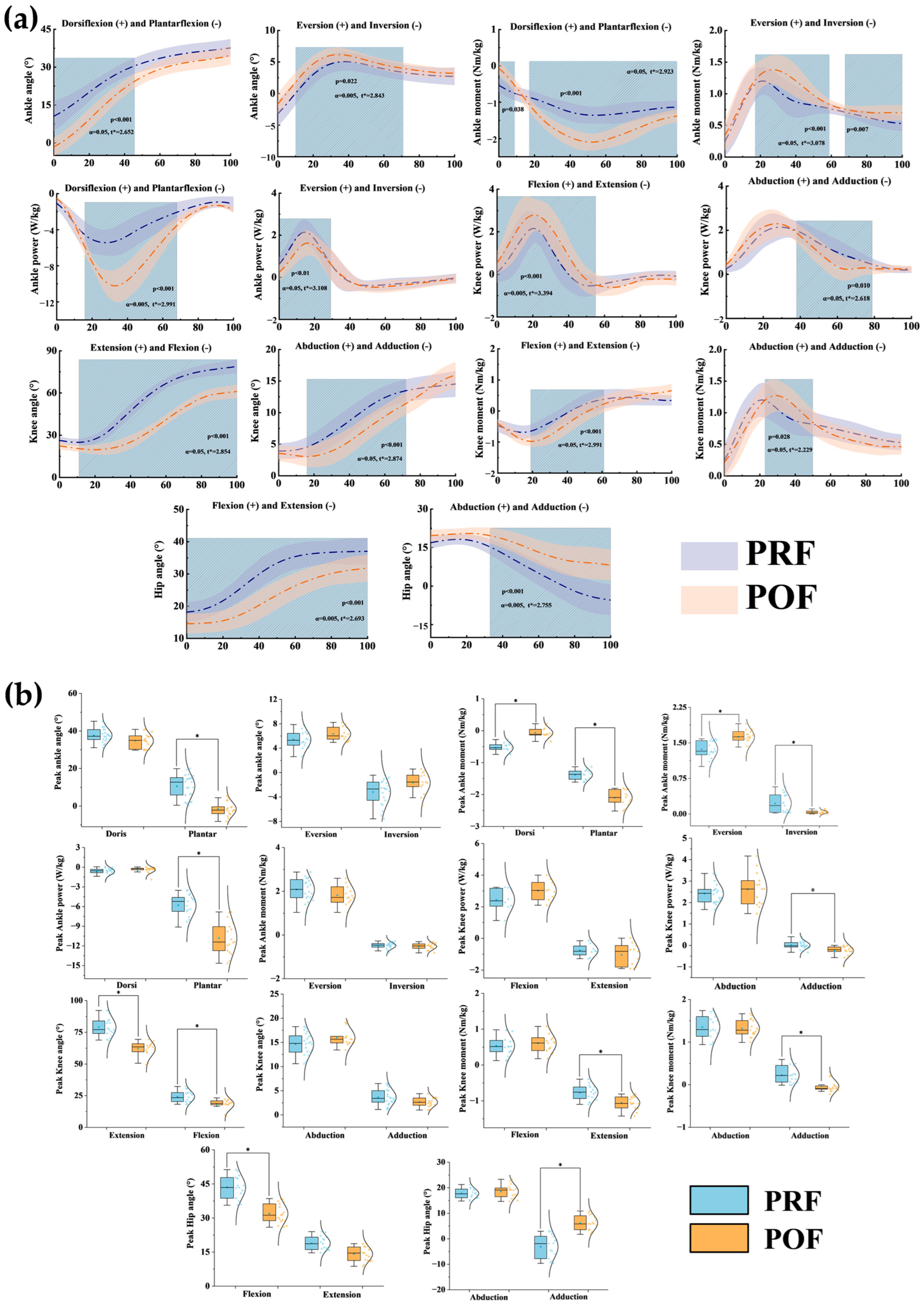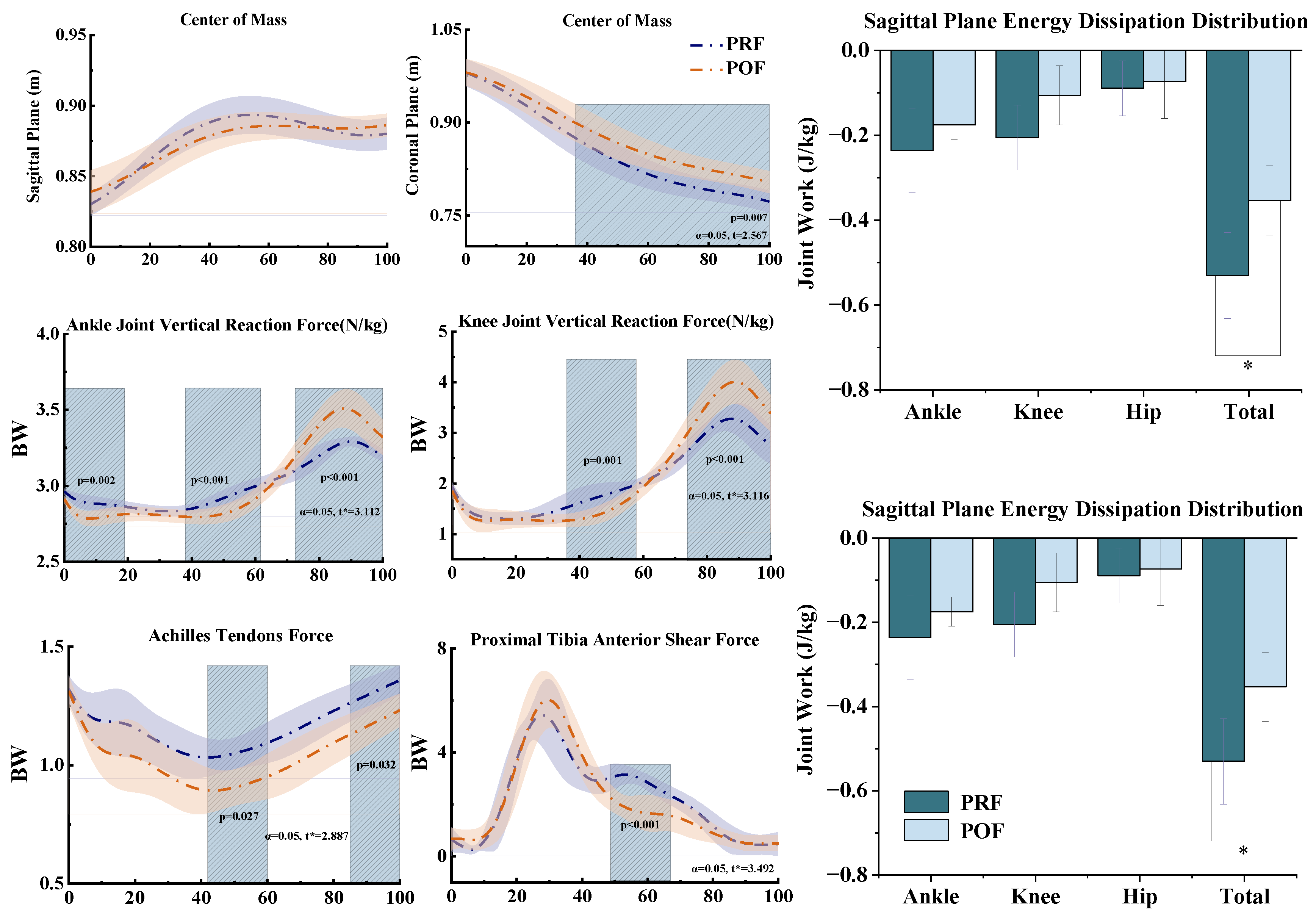Analysis of Quadriceps Fatigue Effects on Lower Extremity Injury Risks During Landing Phases in Badminton Scissor Jump
Abstract
:1. Introduction
2. Materials and Methods
2.1. Participants
2.2. Experimental Protocol and Procedures
2.3. Data Processing and Analysis
2.4. Statistical Analysis
3. Results
3.1. Joint Kinematics and Kinetics
3.2. Muscle Activation
3.3. Center of Mass, Energy Dissipation, Achilles Tendon Force, and Joint Reaction Force
4. Discussion
5. Conclusions
Author Contributions
Funding
Institutional Review Board Statement
Informed Consent Statement
Data Availability Statement
Conflicts of Interest
References
- Phomsoupha, M.; Laffaye, G. The science of badminton: Game characteristics, anthropometry, physiology, visual fitness and biomechanics. Sports Med. 2015, 45, 473–495. [Google Scholar] [CrossRef] [PubMed]
- Shishido, H.; Nishijima, T. Characteristics of split-step skills of the world’s top athletes in badminton. PLoS ONE 2025, 20, e0316632. [Google Scholar] [CrossRef] [PubMed]
- Lin, Y.; Mohamad, N.L. Development of badminton-specific footwork training from traditional physical exercise to novel intervention approaches. Phys. Act. Health 2022, 6, 219–225. [Google Scholar]
- Kaldau, N.C.; Nedergaard, N.J.; Hölmich, P.; Bencke, J. Adjusted Landing Technique Reduces the Load on the Achilles Tendon in Badminton Players. J. Sports Sci. Med. 2022, 21, 224–232. [Google Scholar] [CrossRef]
- Stepper, B.; Hecksteden, A.; Stagge, H.; Faude, O.; Donath, L. Systematic review on badminton injuries: Incidence, characteristics and risk factors. Bmj. Open Sport Exerc. 2025, 11, e002127. [Google Scholar] [CrossRef]
- Kimura, Y.; Ishibashi, Y.; Tsuda, E.; Yamamoto, Y.; Tsukada, H.; Toh, S. Mechanisms for anterior cruciate ligament injuries in badminton. Brit. J. Sport Med. 2010, 44, 1124–1127. [Google Scholar] [CrossRef]
- Bird, S.P.; Markwick, W.J. Musculoskeletal screening and functional testing: Considerations for basketball athletes. Int. J. Sports Phys. Ther. 2016, 11, 784–802. [Google Scholar]
- Herbaut, A.; Delannoy, J. Fatigue increases ankle sprain risk in badminton players: A biomechanical study. J. Sports Sci. 2020, 38, 1560–1565. [Google Scholar] [CrossRef]
- Winnicki, K.; Ochała-Kłos, A.; Rutowicz, B.; Pękala, P.A.; Tomaszewski, K.A. Functional anatomy, histology and biomechanics of the human Achilles tendon—A comprehensive review. Ann. Anat. 2020, 229, 151461. [Google Scholar] [CrossRef]
- Phomsoupha, M.; Laffaye, G. Injuries in badminton: A review. Sci. Sport 2020, 35, 189–199. [Google Scholar] [CrossRef]
- Jones, C.M.; Griffiths, P.C.; Mellalieu, S.D. Training load and fatigue marker associations with injury and illness: A systematic review of longitudinal studies. Sports Med. 2017, 47, 943–974. [Google Scholar] [CrossRef]
- Girard, O.; Millet, G.P. Neuromuscular fatigue in racquet sports. Phys. Med. Rehabil. Clin. N. Am. 2009, 20, 161–173. [Google Scholar] [CrossRef]
- Cortes, N.; Onate, J.; Morrison, S. Differential effects of fatigue on movement variability. Gait Posture 2014, 39, 888–893. [Google Scholar] [CrossRef]
- Hu, F.; Zhang, L.; Zhang, W.A. EEG-Based driver Fatigue Detection using Spatio-Temporal Fusion network with brain region partitioning strategy. IEEE. Trans. Intell. Transp. 2024, 25, 9618–9630. [Google Scholar] [CrossRef]
- Lin, H.T.; Kuo, W.C.; Chen, Y.; Lo, T.Y.; Li, Y.I.; Chang, J.H. Effects of fatigue in lower back muscles on basketball jump shots and landings. Phys. Act. Health 2022, 6, 199. [Google Scholar] [CrossRef]
- He, Z.; Liu, G.; Zhang, B.; Ye, B.; Zhu, H. Impact of specialized fatigue and backhand smash on the ankle biomechanics of female badminton players. Sci. Rep. 2024, 14, 10282. [Google Scholar] [CrossRef] [PubMed]
- Du, Y.; Fan, Y. The Effect of Fatigue on Postural Control and Biomechanical Characteristic of Lunge in Badminton Players. Bioengineering 2023, 10, 301. [Google Scholar] [CrossRef] [PubMed]
- Xiang, L.; Mei, Q.; Wang, A.; Shim, V.; Fernandez, J.; Gu, Y. Evaluating function in the hallux valgus foot following a 12-week minimalist footwear intervention: A pilot computational analysis. J. Biomech. 2022, 132, 110941. [Google Scholar] [CrossRef]
- Chen, C.; Zhou, H.; Xu, D.; Gao, X.; Xiang, L.; Gu, Y. Impact of Quadriceps Muscle Fatigue on Ankle Joint Compensation Strategies During Single-Leg Vertical Jump Landing. Sensors 2024, 24, 6712. [Google Scholar] [CrossRef]
- Xu, D.; Zhou, H.; Quan, W.; Ma, X.; Chon, T.E.; Fernandez, J.; Gusztav, F.; Kovács, A.; Baker, J.S.; Gu, Y. New insights optimize landing strategies to reduce lower limb injury risk. Cyborg Bionic Syst. 2024, 5, 0126. [Google Scholar] [CrossRef]
- Abulhasan, J.F.; Grey, M.J. Anatomy and physiology of knee stability. J. Funct. Morphol. Kinesiol. 2017, 2, 34. [Google Scholar] [CrossRef]
- Murdock, G.H.; Hubley-Kozey, C.L. Effect of a high intensity quadriceps fatigue protocol on knee joint mechanics and muscle activation during gait in young adults. Eur. J. Appl. Physiol. 2012, 112, 439–449. [Google Scholar] [CrossRef] [PubMed]
- Kawabata, R.; Yokoyama, M.; Matsumoto, Y.; Kubota, K.; Kosuge, S.; Sunaga, Y.; Kanemura, N. Lower limb biomechanics and control of center of mass during turning phases in daily gait. J. Electromyography Kines. 2025, 80, 102959. [Google Scholar] [CrossRef]
- Kersting, U.G.; Bulthuis, R.; Lysdal, F.G.; Madsen, C.M. Center of mass displacement during the badminton-specific speed test. ISBS Proc. Arch. 2018, 36, 718. [Google Scholar]
- Tomczak, M.; Tomczak, E.; Kleka, P.; Lew, R. Using power analysis to estimate appropriate sample size. Trends Sport Sci. 2014, 4, 21. [Google Scholar]
- Xu, D.; Lu, J.; Baker, J.S.; Fekete, G.; Gu, Y. Temporal kinematic and kinetics differences throughout different landing ways following volleyball spike shots. Proc. Inst. Mech. Eng. Part P J. Sports Eng. Technol. 2022, 236, 200–208. [Google Scholar] [CrossRef]
- Cheng, K.C.; Chiu, Y.L.; Tsai, C.L.; Hsu, Y.L.; Tsai, Y.J. Fatigue Affects Body Acceleration During Vertical Jumping and Agility Tasks in Elite Young Badminton Players. Sports Health 2024, 17, 126–134. [Google Scholar] [CrossRef]
- Zhang, Z.; Xu, D.; Gao, X.; Liang, M.; Baker, J.S.; Gu, Y. The Effect of Different Degrees of Ankle Dorsiflexion Restriction on the Biomechanics of the Lower Extremity in Stop-Jumping. Appl. Bionics. Biomech. 2024, 2024, 9079982. [Google Scholar] [CrossRef]
- Taylor, J.L.; Burkhart, T.A. Tired of ACL Injures: A Review of Methods and Outcomes of Neuromuscular Fatigue as a Risk Factor for ACL Injuries. Biomechanics 2025, 5, 11. [Google Scholar] [CrossRef]
- Alder, D.B.; Broadbent, D.P.; Stead, J.; Poolton, J. The impact of physiological load on anticipation skills in badminton: From testing to training. J. Sport Sci. 2019, 37, 1816–1823. [Google Scholar] [CrossRef]
- Akhavanfar, M. Enhancing Accuracy and Reliability of Spinal Load Estimation in Lifting/Lowering Tasks: Insights from Inverse Dynamics-Based Multibody Modelling in OpenSim; University of Ottawa: Ottawa, ON, Canada, 2024. [Google Scholar]
- Atkins, L.T.; Yang, H.S.; Chiddarwar, V.; James, C.R. The Influence of Forward Trunk Lean During Single-Limb Landing on Achilles Tendon Force in Physically Active Females. J. Appl. Biomech. 2025, 1, 1–7. [Google Scholar] [CrossRef] [PubMed]
- Rugg, S.G.; Gregor, R.J.; Mandelbaum, B.R.; Chiu, L. In vivo moment arm calculations at the ankle using magnetic resonance imaging (MRI). J. Biomech. 1990, 23, 495–501. [Google Scholar] [CrossRef]
- Self, B.P.; Paine, D. Ankle biomechanics during four landing techniques. Med. Sci. Sport Exer. 2001, 33, 1338–1344. [Google Scholar] [CrossRef] [PubMed]
- Modenese, L.; Barzan, M.; Carty, C.P. Dependency of lower limb joint reaction forces on femoral version. Gait Posture 2021, 88, 318–321. [Google Scholar] [CrossRef] [PubMed]
- Lerner, Z.F.; Gadomski, B.G.; Ipson, A.K.; Haussler, K.K.; Puttlitz, C.M.; Browning, R.C. Modulating tibiofemoral contact force in the sheep hind limb via treadmill walking: Predictions from an opensim musculoskeletal model. J. Orthop. Res. 2015, 33, 1128–1133. [Google Scholar] [CrossRef]
- Pataky, T.C. One-dimensional statistical parametric mapping in Python. Comput. Methods Biomech. Biomed. Eng. 2012, 15, 295–301. [Google Scholar] [CrossRef]
- Xu, D.; Zhou, H.; Quan, W.; Jiang, X.; Liang, M.; Li, S.; Ugbolue, U.C.; Baker, J.S.; Gusztav, F.; Ma, X.; et al. A new method proposed for realizing human gait pattern recognition: Inspirations for the application of sports and clinical gait analysis. Gait Posture 2024, 107, 293–305. [Google Scholar] [CrossRef]
- Jayalath, J.L.R.; Noronha, M.D.; Weerakkody, N.; Bini, R. Effects of fatigue on ankle biomechanics during jumps: A systematic review. J. Electromyorgraphy Kinesiol. 2018, 42, 81–91. [Google Scholar] [CrossRef]
- Markolf, K.L.; Bargar, W.L.; Shoemaker, S.C.; Amstutz, H.C. The role of joint load in knee stability. J. Bone Jt. Surg. Am. 1981, 63, 570–585. [Google Scholar] [CrossRef]
- Lam, W.K.; Wong, D.W.C.; Lee, W.C.C. Biomechanics of lower limb in badminton lunge: A systematic scoping review. Sports Med. Rehabil. J. 2020, 8, 10300. [Google Scholar] [CrossRef]
- Cronström, A.; Creaby, M.W.; Nae, J.; Ageberg, E. Modifiable factors associated with knee abduction during weight-bearing activities: A systematic review and meta-analysis. Sports Med. 2016, 46, 1647–1662. [Google Scholar] [CrossRef] [PubMed]
- Kim, H.; Son, S.J.; Seeley, M.K.; Hopkins, J.T. Altered movement biomechanics in chronic ankle instability, coper, and control groups: Energy absorption and distribution implications. J. Athl. Train. 2019, 54, 708–717. [Google Scholar] [CrossRef]
- Nedergaard, N.J.; Kaldau, N.C.; Hölmich, P.; Bencke, J. Knee Joint Loading Of Scissor-Kick Jump Landings: A Comparison Between Elite And Recreational Badminton Players. ISBS Proc. Arch. 2022, 40, 511. [Google Scholar]
- Zhao, X.; Li, S. A biomechanical analysis of lower limb movement on the backcourt forehand clear stroke among badminton players of different levels. Appl. Bionics Biomech. 2019, 2019, 8. [Google Scholar] [CrossRef]
- Chang, H.; Cen, X. Can running technique modification benefit patellofemoral pain improvement in runners? A systematic review and meta-analysis. Int. J. Biomed. Eng. Tec. 2024, 45, 138706. [Google Scholar] [CrossRef]
- Hu, Z.; Kim, Y.; Zhang, Y.; Zhang, Y.; Li, J.; Tang, X.; Sohn, J.; Kim, S. Correlation of lower limb muscle activity with knee joint kinematics and kinetics during badminton landing tasks. Int. J. Environ. Res. Public Health 2022, 19, 16587. [Google Scholar] [CrossRef] [PubMed]
- Stutzig, N.; Siebert, T. Muscle force compensation among synergistic muscles after fatigue of a single muscle. Hum. Mov. Sci. 2015, 42, 273–287. [Google Scholar] [CrossRef]
- Wilder, D.G.; Aleksiev, A.R.M.; Magnusson, M.L.; Pope, M.H.; Spratt, K.F.; Goel, V.K. Muscular response to sudden load: A tool to evaluate fatigue and rehabilitation. Spine 1996, 21, 2628–2639. [Google Scholar] [CrossRef]
- Xu, D.; Zhou, H.; Sun, D.; Baker, J.S.; Gu, Y. Explaining the differences of gait patterns between high and low-mileage runners with machine learning. Sci. Rep. 2022, 12, 2981. [Google Scholar] [CrossRef]
- Farris, R.J.; Quintero, H.A.; Murray, S.A.; Ha, K.H.; Hartigan, C.; Goldfarb, M. A preliminary assessment of legged mobility provided by a lower limb exoskeleton for persons with paraplegia. IEEE Trans. Neural Syst. Rehabil. 2013, 22, 482–490. [Google Scholar] [CrossRef]
- Almansoof, H.S.; Nuhmani, S.; Muaidi, Q. Role of ankle dorsiflexion in sports performance and injury risk: A narrative review. Electron. J. Gen. Med. 2023, 20, em521. [Google Scholar] [CrossRef] [PubMed]
- Wikstrom, E.A.; Tillman, M.D.; Chmielewski, T.L.; Borsa, P.A. Measurement and evaluation of dynamic joint stability of the knee and ankle after injury. Sports Med. 2006, 36, 393–410. [Google Scholar] [CrossRef] [PubMed]
- Wang, R.; Gutierrez-Farewik, E.M. Compensatory strategies during walking in response to excessive muscle co-contraction at the ankle joint. Gait Posture 2014, 39, 926–932. [Google Scholar] [CrossRef] [PubMed]
- Joseph, M.F.; Lillie, K.R.; Bergeron, D.J.; Cota, K.C.; Yoon, J.S.; Kraemer, W.J.; Denegar, C.R. Achilles tendon biomechanics in response to acute intense exercise. J. Strength. Cond. Res. 2014, 28, 1181–1186. [Google Scholar] [CrossRef]
- Xu, D.; Zhou, H.; Quan, W.; Gusztav, F.; Wang, M.; Baker, J.S.; Gu, Y. Accurately and effectively predict the ACL force: Utilizing biomechanical landing pattern before and after-fatigue. Comput. Methods Programs Biomed. 2023, 241, 107761. [Google Scholar] [CrossRef]
- Kimura, Y.; Ishibashi, Y.; Tsuda, E.; Yamamoto, Y.; Hayashi, Y.; Sato, S. Increased knee valgus alignment and moment during single-leg landing after overhead stroke as a potential risk factor of anterior cruciate ligament injury in badminton. Br. J. Sports Med. 2012, 46, 207–213. [Google Scholar] [CrossRef]
- Liu, K.; Heise, G.D. The effect of jump-landing directions on dynamic stability. J. Appl. Biomech. 2013, 29, 634–638. [Google Scholar] [CrossRef]
- Chin, L.C.; Fook, C.Y.; Nasir, A.S.A.; Basah, S.N.; Din, M.Y.; Zainuddin, Z. Classification of the severity level for lower limb joint injuries. In Proceedings of the 2020 IEEE-EMBS Conference on Biomedical Engineering and Sciences (IECBES), Langkawi Island, Malaysia, 1–3 March 2021. [Google Scholar]
- Fernandez-Fernandez, J.; Tellez, J.D.L.A.; Moya-Ramon, M.; Cabello-Manrique, D.; Mendez-Villanueva, A. Gender differences in game responses during badminton match play. J. Strength Cond. Res. 2013, 27, 2396–2404. [Google Scholar] [CrossRef]
- Kim, H.; Lee, J.; Kim, J. Electromyography-signal-based muscle fatigue assessment for knee rehabilitation monitoring systems. Biomed. Eng. Lett. 2018, 8, 345–353. [Google Scholar] [CrossRef]






| Parameters | Peak Value | Before (Mean ± SD) | Fatigue (Mean ± SD) | p-Value | Effect Size |
|---|---|---|---|---|---|
| Ankle Angle (°) | Dorsiflexion | 37.70 ± 3.69 | 34.73 ± 3.80 | 0.055 | 0.37 |
| Plantarflexion | 10.80 ± 6.40 | −1.59 ± 0.87 | <0.001 * | 0.80 | |
| Eversion | 5.66 ± 1.52 | 6.34 ± 1.07 | 0.146 | 0.25 | |
| Inversion | −3.22 ± 2.06 | −1.65 ± 1.72 | 0.072 | 0.38 | |
| Knee Angle (°) | Extension | 78.94 ± 2.96 | 61.08 ± 2.71 | <0.001 * | 0.95 |
| Flexion | 24.95 ± 5.41 | 19.74 ± 3.80 | <0.001 * | 0.49 | |
| Abduction | 14.88 ± 2.56 | 15.99 ± 1.77 | 0.147 | 0.24 | |
| Adduction | 3.37 ± 1.44 | 2.63 ± 0.97 | 0.143 | 0.29 | |
| Hip Angle (°) | Flexion | 43.48 ± 5.08 | 31.91 ± 4.61 | <0.001 * | 0.77 |
| Extension | 18.85 ± 3.10 | 14.70 ± 3.08 | 0.002 * | 0.56 | |
| Abduction | 17.75 ± 1.90 | 18.24 ± 2.37 | 0.521 | 0.11 | |
| Adduction | −3.12 ± 4.44 | 5.90 ± 2.77 | <0.001 * | 0.77 |
| Parameters | Peak Value | Before (Mean ± SD) | Fatigue (Mean ± SD) | p-Value | Effect Size |
|---|---|---|---|---|---|
| Ankle Moment (Nm/kg) | Dorsiflexion | −0.54 ± 0.16 | −0.07 ± 0.15 | <0.001 * | 0.83 |
| Plantarflexion | −1.38 ± 0.16 | −2.10 ± 0.24 | <0.001 * | 0.87 | |
| Eversion | 1.37 ± 0.18 | 1.63 ± 0.16 | <0.001 * | 0.61 | |
| Inversion | 0.22 ± 0.20 | 0.04 ± 0.03 | 0.001 * | 0.53 | |
| Ankle Power (W/kg) | Dorsiflexion | −0.63 ± 0.52 | −0.39 ± 0.45 | 0.169 | 0.24 |
| Plantarflexion | −5.80 ± 1.71 | −10.79 ± 2.46 | <0.001 * | 0.76 | |
| Eversion | 2.48 ± 1.05 | −0.49 ± 0.14 | <0.001 * | 0.89 | |
| Inversion | 1.82 ± 0.45 | −0.53 ± 0.15 | <0.001 * | 0.96 | |
| Knee Moment (Nm/kg) | Flexion | 0.50 ± 0.26 | 0.62 ± 0.26 | 0.224 | 0.22 |
| Extension | −0.75 ± 0.20 | −1.06 ± 0.18 | <0.001 * | 0.63 | |
| Abduction | 1.35 ± 0.27 | 1.33 ± 0.21 | 0.77 | 0.63 | |
| Adduction | 0.22 ± 0.20 | −0.08 ± 0.09 | <0.001 * | 0.70 | |
| Knee Power (W/kg) | Flexion | 2.44 ± 0.73 | 2.95 ± 0.61 | 0.203 | 0.35 |
| Extension | −0.76 ± 0.39 | −1.17 ± 0.70 | 0.191 | 0.34 | |
| Abduction | 2.50 ± 0.51 | 2.61 ± 0.78 | 0.66 | 0.08 | |
| Adduction | 0.03 ± 0.18 | −0.25 ± 0.26 | 0.005 * | 0.53 |
Disclaimer/Publisher’s Note: The statements, opinions and data contained in all publications are solely those of the individual author(s) and contributor(s) and not of MDPI and/or the editor(s). MDPI and/or the editor(s) disclaim responsibility for any injury to people or property resulting from any ideas, methods, instructions or products referred to in the content. |
© 2025 by the authors. Licensee MDPI, Basel, Switzerland. This article is an open access article distributed under the terms and conditions of the Creative Commons Attribution (CC BY) license (https://creativecommons.org/licenses/by/4.0/).
Share and Cite
Wen, J.; Xu, D.; Zhou, H.; Zhang, Z.; Xiang, L.; Munivrana, G.; Gu, Y. Analysis of Quadriceps Fatigue Effects on Lower Extremity Injury Risks During Landing Phases in Badminton Scissor Jump. Sensors 2025, 25, 2536. https://doi.org/10.3390/s25082536
Wen J, Xu D, Zhou H, Zhang Z, Xiang L, Munivrana G, Gu Y. Analysis of Quadriceps Fatigue Effects on Lower Extremity Injury Risks During Landing Phases in Badminton Scissor Jump. Sensors. 2025; 25(8):2536. https://doi.org/10.3390/s25082536
Chicago/Turabian StyleWen, Jun, Datao Xu, Huiyu Zhou, Zanni Zhang, Liangliang Xiang, Goran Munivrana, and Yaodong Gu. 2025. "Analysis of Quadriceps Fatigue Effects on Lower Extremity Injury Risks During Landing Phases in Badminton Scissor Jump" Sensors 25, no. 8: 2536. https://doi.org/10.3390/s25082536
APA StyleWen, J., Xu, D., Zhou, H., Zhang, Z., Xiang, L., Munivrana, G., & Gu, Y. (2025). Analysis of Quadriceps Fatigue Effects on Lower Extremity Injury Risks During Landing Phases in Badminton Scissor Jump. Sensors, 25(8), 2536. https://doi.org/10.3390/s25082536








